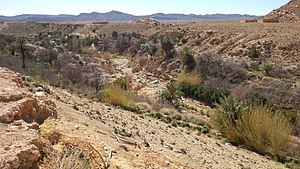

Deserts and xeric shrublands are a biome defined by the World Wide Fund for Nature.[1] Deserts and xeric (Ancient Greek ξηρός xērós 'dry') shrublands form the largest terrestrial biome, covering 19% of Earth's land surface area.[2] Ecoregions in this habitat type vary greatly in the amount of annual rainfall they receive, usually less than 250 millimetres (10 in) annually except in the margins. Generally evaporation exceeds rainfall in these ecoregions. Temperature variability is also diverse in these lands. Many deserts, such as the Sahara, are hot year-round, but others, such as East Asia's Gobi Desert, become quite cold during the winter.[1]
Temperature extremes are a characteristic of most deserts. High daytime temperatures give way to cold nights because there is no insulation provided by humidity and cloud cover. The diversity of climatic conditions, though quite harsh, supports a rich array of habitats. Many of these habitats are ephemeral in nature, reflecting the paucity and seasonality of available water.[1] Woody-stemmed shrubs and plants characterize vegetation in these regions. Above all, these plants have evolved to minimize water loss. Animal biodiversity is equally well adapted and quite diverse.[1]
- ^ a b c d
 This article incorporates text available under the CC BY-SA 3.0 license. World Wide Fund for Nature. "Deserts and Xeric Shrubland Ecoregions". Archived from the original on 2012-04-25. Retrieved 2019-05-29.
This article incorporates text available under the CC BY-SA 3.0 license. World Wide Fund for Nature. "Deserts and Xeric Shrubland Ecoregions". Archived from the original on 2012-04-25. Retrieved 2019-05-29.
- ^ Lockwood, M. Managing Protected Areas: A Global Guide. p. 199.